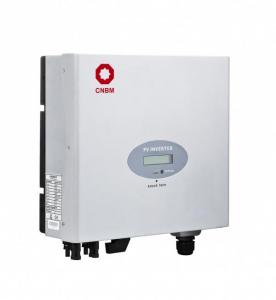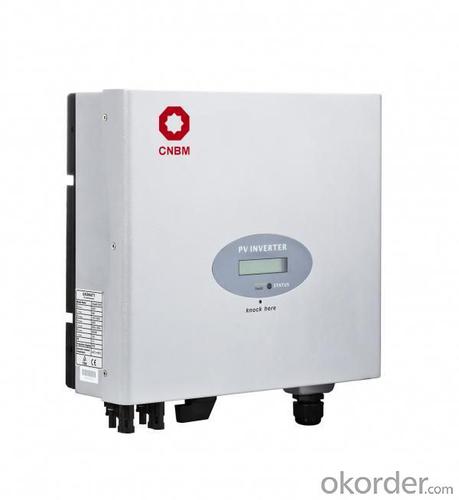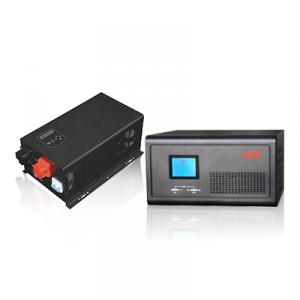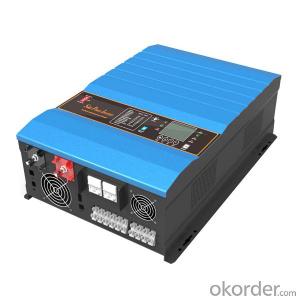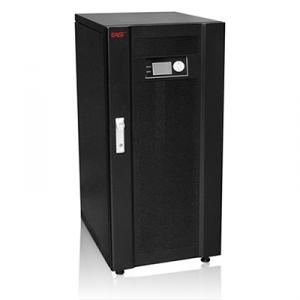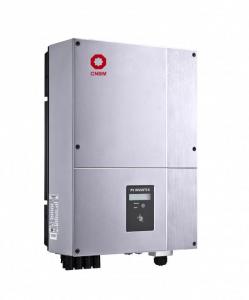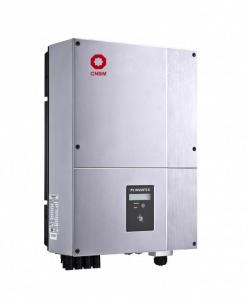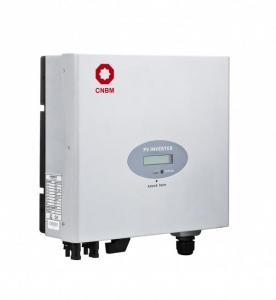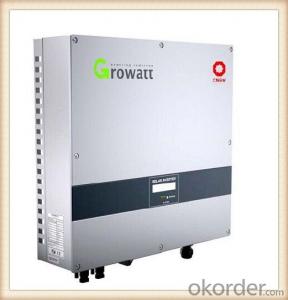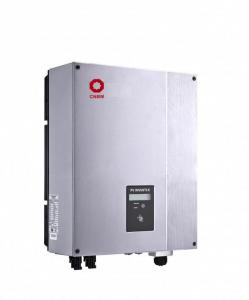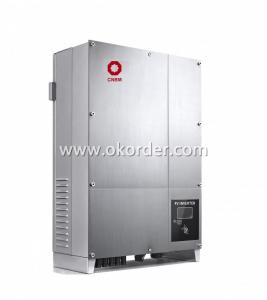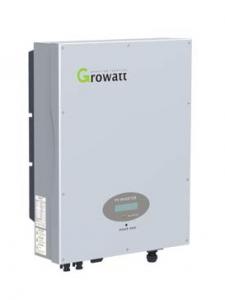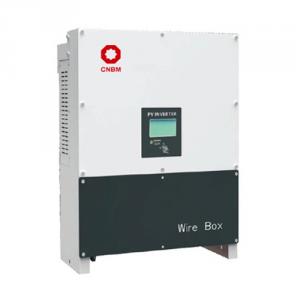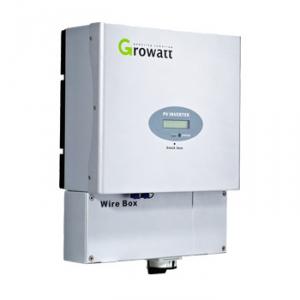Solar Inverter Charger Controller CNBM-1500TL Grid Tied Solar Inverter
- Loading Port:
- SHENZHEN
- Payment Terms:
- TT or LC
- Min Order Qty:
- 1set set
- Supply Capability:
- 5000 per month set/month
OKorder Service Pledge
OKorder Financial Service
You Might Also Like
Features of Grid Tied Solar Inverter CNBM-1500TL
With a R&D team more than 100 engineers,40% of the staff, who has been deeply engaged in the photovoltaic industry for 10 years, CNBM takes the mission to increase the inverter availability and efficiency, putting continuous innovation to make CNBM inverter easier for installation and operation, and more cost-effective for solar plant construction. The full range of CNBM single phase inverters has received VDE, CE, G83/1, G59/2, ENEL2010, VDE4105, C10/C11, AS4777 etc.
Maximum efficiency of 97.8% and wide input voltage range, Internal DCswitch,MTL-String, Sound control,Bluetooth/RF technology /Wi-FiTransformerless,GT topology
Technical data of Grid Tied Solar Inverter CNBM-1500TL
Model | CNBM-1000TL | CNBM-1500TL | |
Input data (DC) |
|
| |
Max. DC power | 1300W | 1800W | |
Max. DC voltage | 450V | 450V | |
Start voltage | 90V | 150V | |
PV voltage range | 70V-450V | 100V-450V | |
Max. input current | 10A | 10A | |
Number of MPP trackers /strings per MPP tracker | 1/1 | 1/1 | |
Output (AC) |
| ||
Rated AC output power | 1000W | 1600W | |
Max. AC power | 1100W | 1650W | |
Max. output current | 5.5A | 8A | |
Power factor | 1 | 1 | |
THDI | <3% | <3% | |
AC connection | Single phase | Single phase | |
Efficiency |
| ||
Max. efficiency | 97% | 97% | |
Euro weighted efficiency | 96.50% | 96.50% | |
MPPT efficiency | 99.50% | 99.50% | |
Protection devices |
| ||
Output over voltage protection-varistor | yes | yes | |
Ground fault monitoring | yes | yes | |
Grid monitoring | yes | yes | |
General Data |
| ||
Dimensions (W / H / D) in mm | 360/329/132 | 360/329/132 | |
Weight | 11.5KG | 11.5KG | |
Operating temperature range | –25°C ... +60°C | –25°C ... +60°C | |
Altitude | 2000m(6560ft) without derating | ||
Self-Consumption night | < 0.5 W | < 0.5 W | |
Topology | Transformerless | ||
Cooling concept | Natural | Natural | |
Environmental Protection Rating | IP65 | IP65 | |
Features |
| ||
DC connection | H4/MC4(opt) | H4/MC4(opt) | |
Display | LCD | LCD | |
Interfaces: RS485/RS232/Bluetooth / RF/Zigbee/Wifi | yes/yes/opt/opt/opt | ||
Warranty: 5 years / 10 years | yes /opt | ||
Certificates and approvals | CE、VDE 0126-1-1、DK5940、G83/1-1、G59/2、RD1663、EN50438、 VDE-AR-N4105、CEI-021、IEC-62109、ENEL-Guide | ||
CNBM-1500TL is simple national setting of line supply monitoring, Easy country configuration, with Multi-language,display, currently available for most of the countries over the world.With technical creativity and scientific management, the factory established first class R&D and test centers, as well as management and R&D teams comprising of PhDs and masters with overseas qualification.
Figure 1 the application of Grid Tied Solar Inverter CNBM-1500TL
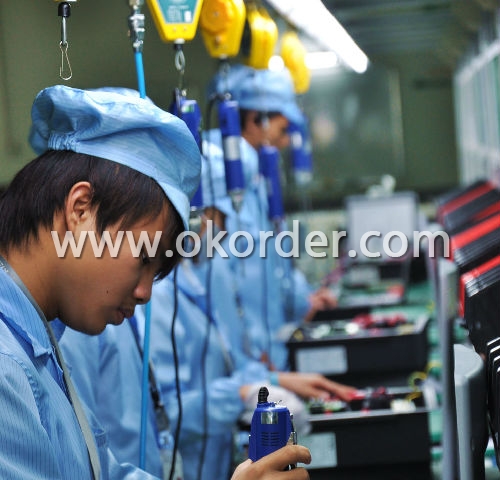
Figure 2 the application of Grid Tied Solar Inverter CNBM-1500TL
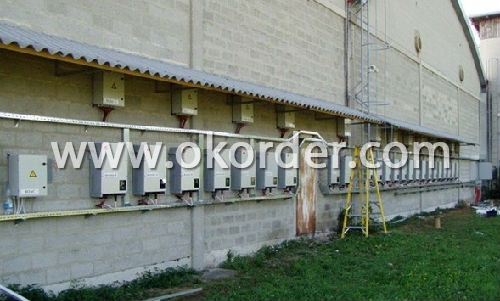
- Q: How do you connect a solar inverter to a data monitoring system?
- To connect a solar inverter to a data monitoring system, you typically need to connect the inverter to a communication gateway or data logger. This can be done through wired connections such as Ethernet or RS485, or wirelessly using Wi-Fi or cellular networks. The data monitoring system will then collect and analyze the data from the inverter, providing real-time monitoring and reporting on the solar power generation and system performance.
- Q: Can a solar inverter be used in a three-phase power system?
- Yes, a solar inverter can be used in a three-phase power system. In fact, three-phase solar inverters are commonly used in commercial and industrial applications where three-phase power is utilized. These inverters convert the DC power generated by solar panels into AC power that can be seamlessly integrated into the three-phase power grid.
- Q: How does a solar inverter handle power factor correction?
- A solar inverter handles power factor correction by continuously monitoring the power factor of the electrical load and adjusting its operation accordingly. It applies various control techniques to ensure that the power factor is maintained close to unity, ultimately improving the efficiency and stability of the solar power system.
- Q: How does a solar inverter synchronize with the grid frequency?
- A solar inverter synchronizes with the grid frequency by constantly monitoring the frequency of the utility grid. It adjusts its own output frequency accordingly to match the grid frequency. This synchronization process ensures that the solar inverter's power output is in phase with the utility grid, allowing it to seamlessly inject solar energy into the grid without any disruptions or compatibility issues.
- Q: What is the maximum number of solar panels that a solar inverter can support?
- The maximum number of solar panels that a solar inverter can support depends on the specific model and its capacity. However, most solar inverters are designed to support a certain capacity or power rating, rather than a specific number of panels. The capacity of the solar inverter, measured in kilowatts (kW) or megawatts (MW), determines the maximum power output it can handle. The number of panels that can be connected to the inverter depends on the power rating of each panel. So, it is best to consult the manufacturer's specifications or seek professional advice to determine the maximum number of panels that can be supported by a specific solar inverter.
- Q: Can a solar inverter be used for off-grid applications?
- Yes, a solar inverter can be used for off-grid applications. Off-grid systems typically rely on solar panels to generate power, and a solar inverter is used to convert the direct current (DC) produced by the panels into alternating current (AC) which can be used to power appliances and devices. The inverter also helps regulate the flow of electricity and ensure compatibility with off-grid power storage systems such as batteries.
- Q: Can a solar inverter be used in regions with high levels of dust or debris?
- Yes, solar inverters can be used in regions with high levels of dust or debris. However, it is important to regularly clean and maintain the solar panels and inverters to ensure optimal performance and prevent any potential damage caused by the accumulation of dust or debris.
- Q: Is the PV inverter a current source or a voltage source?
- Inverter is a kind of semiconductor device composed of power adjustment device, mainly used for DC power into AC power.
- Q: How does a solar inverter synchronize with the electrical grid?
- A solar inverter synchronizes with the electrical grid through a process called grid synchronization. This involves the inverter constantly monitoring the voltage and frequency of the grid and adjusting its own output accordingly to match the grid's parameters. Once the inverter's output matches the grid's voltage and frequency, it can seamlessly feed the solar-generated electricity into the grid, ensuring safe and efficient integration of solar power into the existing electrical infrastructure.
- Q: Can a solar inverter be used with different types of energy management systems?
- Yes, a solar inverter can be used with different types of energy management systems. Solar inverters are designed to convert the DC (direct current) electricity generated by solar panels into AC (alternating current) electricity that can be used to power various electrical devices and appliances. These inverters can be integrated with different energy management systems, such as smart grids or battery storage systems, to optimize energy usage, monitor performance, and enhance overall energy efficiency.
Send your message to us
Solar Inverter Charger Controller CNBM-1500TL Grid Tied Solar Inverter
- Loading Port:
- SHENZHEN
- Payment Terms:
- TT or LC
- Min Order Qty:
- 1set set
- Supply Capability:
- 5000 per month set/month
OKorder Service Pledge
OKorder Financial Service
Similar products
Hot products
Hot Searches
Related keywords
